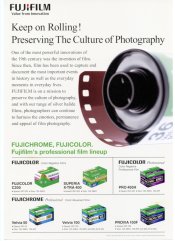Agulliver
Member
If Fuji release a new B&W film it will be because they believe they can produce something that will sell before it expires. However I do tend to agree that Neopan 400 doesn't have much of a unique selling point when we have several ISO400 B&W pan films (T-MAX, Tri-X, HP5+, Delta 400, Ilford Pan 400, Kentmere 400, Fomapan 400, Bergger Pan 400, probably more I'm not thinking of)
The niches in the market would appear to be low speed, as there's little under 100ISO (PanF+ and a couple of Adox films)...only Foma at 200....nothing at 800 or 1600 without push/pull.
If Fuji releases something new it will have to make economic sense for Fuji.....but since they are quite secretive we can only guess what that might mean.
The niches in the market would appear to be low speed, as there's little under 100ISO (PanF+ and a couple of Adox films)...only Foma at 200....nothing at 800 or 1600 without push/pull.
If Fuji releases something new it will have to make economic sense for Fuji.....but since they are quite secretive we can only guess what that might mean.





